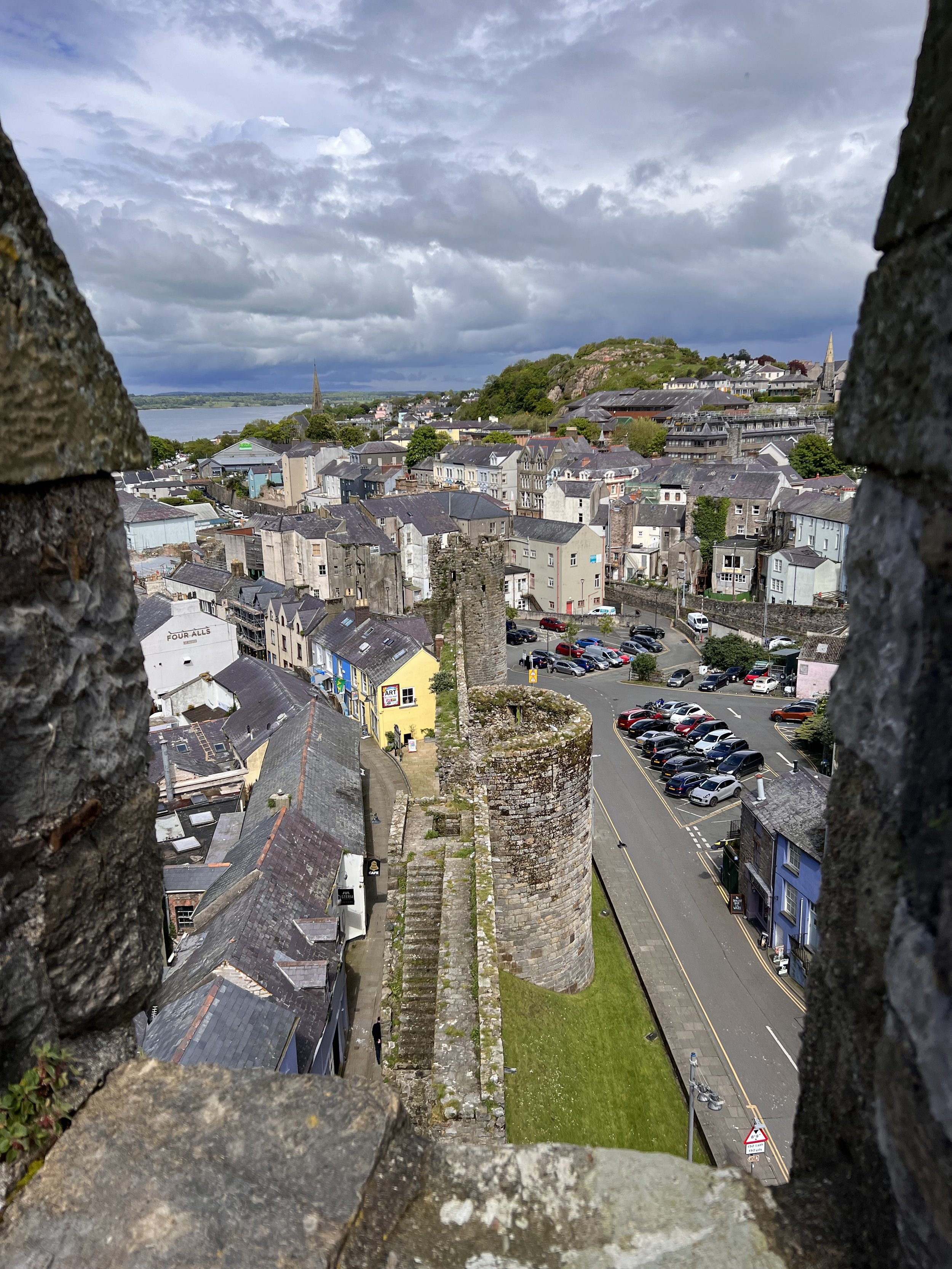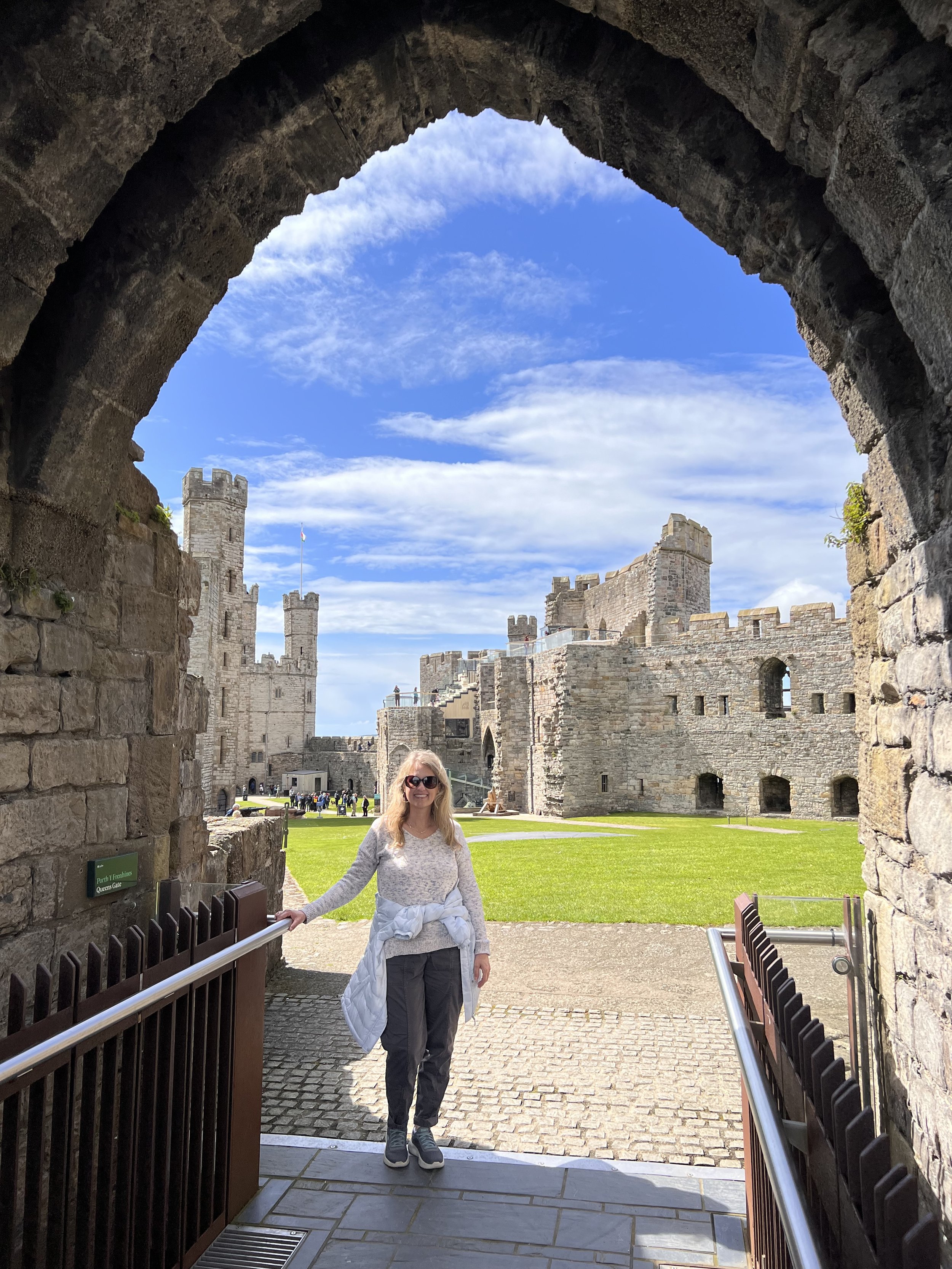Hwyl Fawr Cymru!
Hwyl Fawr Cymru—A “Big Goodbye to Wales.”
“That men do not learn very much from the lessons of history, is the most important of all the lessons of history.”
Harlech Castle
Harlech Castle was built by Edward I during his invasion of Wales between 1282 and 1289.
Over 700 years later, twin Welsh Red Dragons are proudly unfurled over the once English stronghold.
Amanda on the bridge before the gatehouse with smaller corbelled towers in front.
As this diarama depicts, Harlech Castle crowns an impressive rocky crag. While the ocean once lapped at its base, a great expanse of dunes now stands between the castle and the Irish Sea.
A glorious day looking north from the Southeast Tower.
Imagine if these stairs could tell of the footfall they have experienced over the past 740 years!
Hold your kid’s hands up here—the walls are only 3-feet tall! 😬
Caernarfon Castle
Construction on Caernarfon Castle (ker·naar·ven) started in 1283 when King Edward I of England began to replace the previous castle with the current structure.
Because the Edwardian town and castle acted as the administrative center of North Wales, its defenses were built on a grand scale.
A drawing of the castle and the walled city in its heyday.
The town walls built around Caernarfon remain a prominent feature of the cityscape.
This is the first castle we’ve visited that has an elaborate series of interior corridors with defensive positions capable of defending not only the castle’s exterior, but also the inner courtyard as well.
It’s a true pleasure to see castle rooms such as these with floors restored.
While the stone withstands the ravages of time, wooden floors rot away and disappear. In most castles, doorways, windows, and fireplaces float like ghosts upon the walls—your mind left to recreate the rooms as they once were. Caernarfon provides a rare glimpse of multi-level living inside a medieval (1066-1485) fortified castles.
Investiture of the Prince of Wales
On July 26, 1958, Charles III was made the Prince of Wales by his mother Queen Elizabeth II when he was just nine.
In 1969, Charles was formally invested with the title by his mother amid great pomp and ceremony at Caernarfon Castle at the age of 20.
Little did Charles know that when he stood on this platform, he would have to wait 54 years—until May 2023—before he would be crowned King.
The Investiture platform behind Amanda.
This is the interior of the Queen’s Gate.
It was from this balcony in 1969 at the Queen’s Gate that Queen Elizabeth formally presented Charles III as the Prince of Wales to the crowds amassed below.
The same balcony today.
The view east from the triple turreted Eagle tower, heavy rains falling over Snowdonia National Park.
View over the Queen’s Tower of the approaching storm and the Afon Seiont (River Seiont).
From the turret on Eagle Tower, looking down over the Menai Strait and, more importantly—like a barnacle attached to the outside of the old town wall—the former 18th-century customs house and now Anglesey Arms pub.
We may not have watched Welcome to Wrexham before or even during our trip 😔 but at least we had a Wrexham lager! It was excellent!
Once the rain passed, it was time for one more stop before returning home.
Gelert's Grave
Nestled in a valley at the confluence of the Rivers Glaslyn and Colwyn sits the picturesque village of Beddgelert.
Just above the confluence, in the center of the village, is an old stone bridge with two arches.
Yr Wyddfa (Snowdon Peak) towers beyond Beddgelert.
The town name Beddgelert means "Gelert's Grave."
In the middle of this field lies a stone allegedly marking the grave of a legendary hound named Gelert.
The Legend of Gelert:
In the 13th century, Llywelyn, Prince of North Wales, had a palace at Beddgelert.
One day, he went hunting without Gelert “The Faithful Hound,” who was unaccountably absent. On Llywleyn’s return, the truant, stained and smeared with blood, joyfully sprang to meet his master. The prince alarmed, hastened to find his son, and saw the infant’s cot empty, the bedclothes and floor covered with blood.
The frantic father plunged his sword into the hound’s side thinking he had killed his heir. The dog’s dying yell was answered by a child’s cry. Llywelyn searched and discovered his boy unharmed, but nearby lay the body of a mighty wolf, which Gelert had slain.
The prince filled with remorse is said never to have smiled again. He buried Gelert here. The spot is called Beddgelert.
The stone and plaques (one in Welsh and one in English).
Does it matter that the story is a variation on the Faithful Hound folktale motif that lives on as an urban legend?
(And am I the only one who didn’t know that sheep climb around just like goats?)
Does it matter that the "grave" mound is ascribed to David Prichard, landlord of the Goat Hotel in Beddgelert in the late eighteenth century, who connected the legend to the village to encourage tourism?
No. Not one bit. We love this little scamp and feel sorry for his cruel and untimely death. We rather hope Lyywelyn the Great rots in hell for what he did (or never did) to his poor, faithful hound.
It is now accepted that the village of Beddgelert took its name from an early saint named Kilart or Celery, rather than from the dog. (Poppycock! A lot of codswallop I say!)
Outside a shop not at all devoted to the mass of tourists who flood to Beddgelert looking to visit “Gelert’s grave,” stands this amazing carved Welsh dragon.
Dad, this amazing carved eagle is for you!
A tourist eating sorbet beneath Snowdon.
Evening settles in over Cae Canol Farmhouse on our final night in Wales.
Goodnight Wales!













































